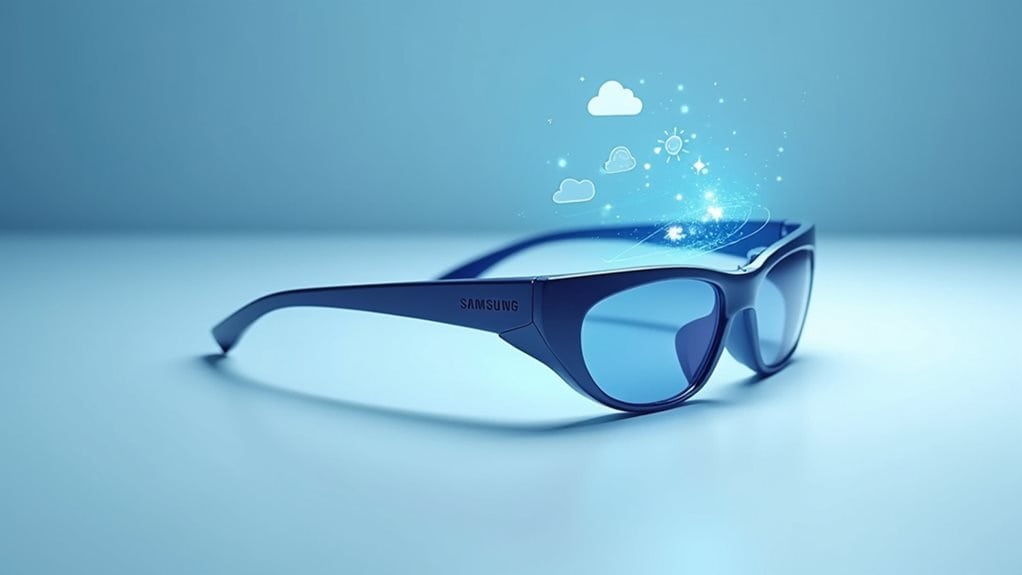Samsung's "Haean" smart glasses are set to launch by late 2025, featuring AI technology powered by Google's Gemini model and a 12MP Sony camera. You'll experience gesture controls and QR-based payments in a lightweight 50-gram design built to fit diverse face shapes. The glasses will compete directly with Meta's Ray-Ban line, with Samsung planning an initial production of 500,000 units. The collaboration with Google and Qualcomm signals a potentially transformative entry into wearable AR technology.

Samsung is developing a groundbreaking pair of smart glasses codenamed "Haean," set to launch by the end of 2025. The company is working closely with tech giants Google and Qualcomm to create these advanced wearables that will incorporate sophisticated AI technology and gesture controls.
The smart glasses will weigh approximately 50 grams, making them comfortable for extended wear. You'll be able to use them for longer periods thanks to their 155mAh battery, designed for efficient power management. Samsung's meticulous design process focuses on fitting various face structures to ensure universal comfort.
A high-resolution 12MP Sony IMX681 camera will be integrated into the frames, allowing you to capture images and potentially enabling augmented reality features. The glasses were initially planned to use Qualcomm's AR1 chip, though Samsung may opt for newer models as development continues.
Google's Gemini large language model will power the AI features of these glasses, allowing for smarter interactions with your environment. You'll be able to control the device through hand gestures, eliminating the need for numerous physical buttons and maintaining a sleek design.
The smart glasses will support practical functions like QR-based payments and human recognition through AI technology. An NXP auxiliary processor will provide additional computing power for smoother operations.
Samsung's "Haean" glasses will directly compete with existing products like Meta's Ray-Ban smart glasses. The company aims to price them affordably to attract a wider audience.
The smart glasses market has seen previous unsuccessful attempts, but Samsung believes advances in AR technology will make their product more appealing and useful. These glasses are designed to fit various face shapes, ensuring comfort for a diverse range of users.
You might see these glasses revealed alongside other Samsung XR devices, possibly including Project Moohan. The glasses will run on Android XR software, potentially offering integrated augmented reality experiences that blend seamlessly with your daily activities. Samsung plans an initial production run of 500,000 units when they launch in Q3 2025.
When they arrive in late 2025, will you be ready to incorporate AI-powered glasses into your daily life?
Frequently Asked Questions
How Much Will Samsung's AI Smart Glasses Cost?
You can expect Samsung's AI smart glasses to cost between $299 and $349.
This pricing aligns with Meta's Ray-Ban smart glasses, which start at $299. Samsung will likely match this price point to remain competitive in the market.
If they include additional advanced features or enhanced AI capabilities from their Google partnership, the price might reach the higher end of this range.
Final pricing remains speculative until Samsung makes an official announcement.
Will the Glasses Work With Non-Samsung Smartphones?
While Samsung hasn't confirmed complete cross-brand compatibility, there's a good chance the glasses will work with non-Samsung smartphones.
You'll likely experience better integration with Samsung devices, but the Android XR platform and Qualcomm's AR1 chip suggest broader Android compatibility.
Bluetooth connectivity could enable basic functions with various phones.
However, you might miss some premium features that require Samsung's ecosystem.
The final compatibility details will become clearer when Samsung releases official specifications.
How Long Does the Battery Last on a Single Charge?
The exact battery life of Samsung's smart glasses hasn't been officially confirmed.
With a 155mAh battery, you can expect performance similar to comparable devices like the Ray-Ban Meta glasses.
Your usage patterns will greatly impact battery duration.
Features such as gesture recognition and QR-based payments will consume more power when frequently used.
The glasses are designed with power efficiency in mind, allowing you to perform basic functions without constant smartphone connectivity.
Can Prescription Lenses Be Integrated Into the Smart Glasses?
Yes, prescription lenses can be integrated into smart glasses, though approaches vary by brand.
The Even Realities G1 directly integrates prescriptions into their glasses through optical gluing to waveguides, offering single vision and astigmatism correction for an additional $150.
Other brands like Vuzix Blade 2 use snap-in prescription inserts instead.
The integrated approach gives a cleaner look but requires buying new glasses when your prescription changes, unlike replaceable inserts.
What Privacy Protections Prevent Unauthorized Facial Recognition Use?
Your privacy is protected from unauthorized facial recognition through several legal frameworks.
The CCPA regulates facial data as personal information, while Illinois' BIPA requires explicit consent before collection. Many jurisdictions implement notice requirements, mandating clear disclosure about facial recognition use.
You'll find opt-out rights in some states, allowing you to prevent the sale of your facial data. However, protections vary greatly by location since the U.S. lacks thorough federal regulation.





